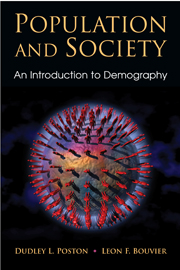Book contents
- Frontmatter
- Contents
- Preface
- Introduction
- 1 “We Are All Population Actors”: An Introduction to Demography
- 2 The Sources of Demographic Information
- 3 Fertility
- 4 Contraception and Birth Control
- 5 Mortality
- 6 Internal Migration
- 7 International Migration
- 8 Age and Sex Composition
- 9 World Population Change over Time
- 10 Population Change in the United States
- 11 Population Distribution
- 12 Cultural Adaptation and Growth
- 13 Population Policy
- 14 The Future of Planet Earth
- Glossary
- References
- Author Index
- Subject Index
10 - Population Change in the United States
- Frontmatter
- Contents
- Preface
- Introduction
- 1 “We Are All Population Actors”: An Introduction to Demography
- 2 The Sources of Demographic Information
- 3 Fertility
- 4 Contraception and Birth Control
- 5 Mortality
- 6 Internal Migration
- 7 International Migration
- 8 Age and Sex Composition
- 9 World Population Change over Time
- 10 Population Change in the United States
- 11 Population Distribution
- 12 Cultural Adaptation and Growth
- 13 Population Policy
- 14 The Future of Planet Earth
- Glossary
- References
- Author Index
- Subject Index
Summary
INTRODUCTION
The United States is the third most populous country in the world after the two demographic billionaires, China and India. In 2007, the population of the United States numbered 302 million inhabitants, compared to 1.3 billion in China and 1.1 billion in India. When the first census was taken in the United States in 1790, the population size of the country (as then defined geographically) was just under 4 million, the size today of the city of Los Angeles. In less than 220 years, the United States has increased tremendously in size, from 3.9 million inhabitants in 1790 to more than 281 million in 2000 (Figure 10.1) to more than 302 million in 2007. In this chapter, we trace the patterns of growth of the United States from colonial times to the present and then examine some projections of the population for the future.
HISTORY OF POPULATION CHANGE IN THE UNITED STATES
The precolonial period
Estimates for the precolonization period of the size of the population in the land now known as the United States are difficult to come by, and they vary considerably: “There is probably no single figure that can be accepted as the ‘best’ estimate of the late fifteenth century North American population” (Snipp, 1989: 9). According to Howard Zinn (2003: 16):
The Indian population of [around] 10 million that lived north of Mexico when Columbus came would ultimately be reduced to less than a million. Huge numbers of Indians would die from diseases introduced by the Whites. […]
- Type
- Chapter
- Information
- Population and SocietyAn Introduction to Demography, pp. 286 - 300Publisher: Cambridge University PressPrint publication year: 2010



